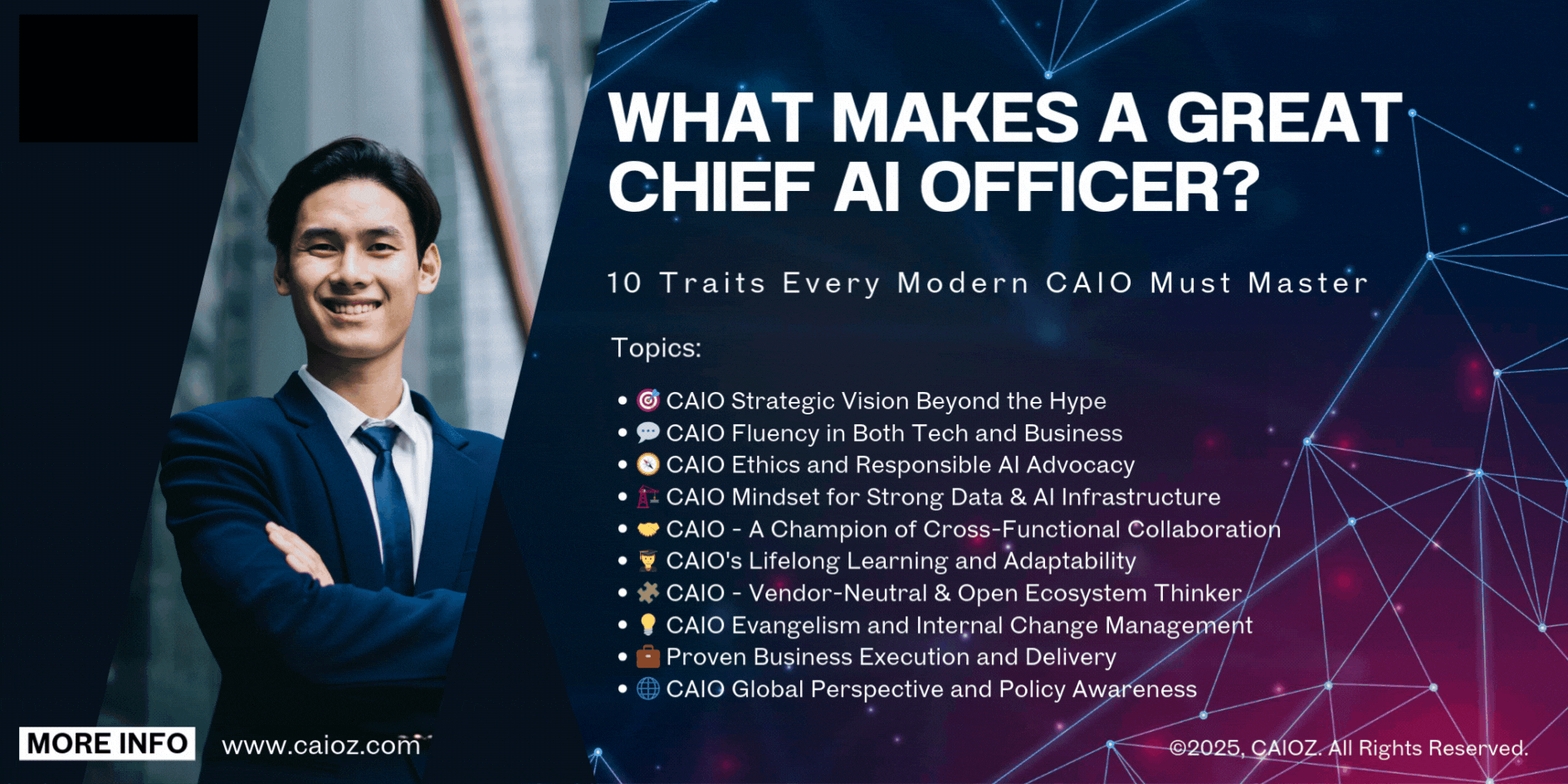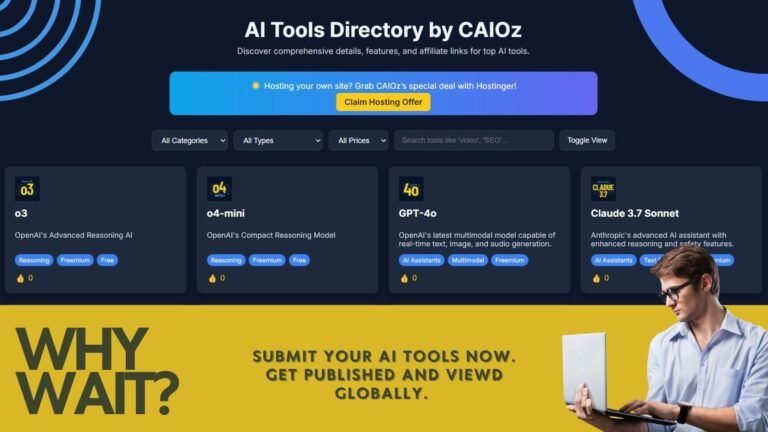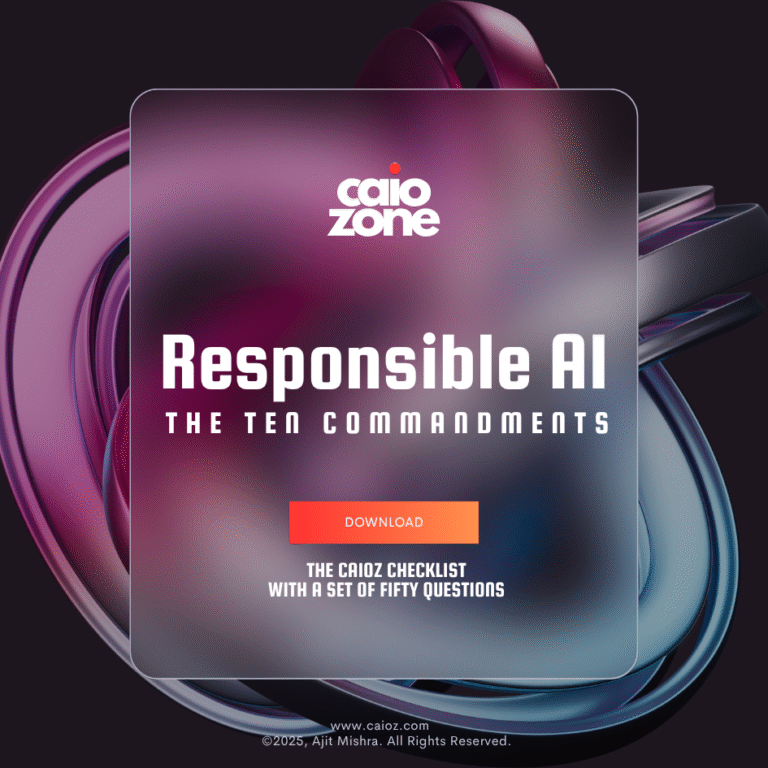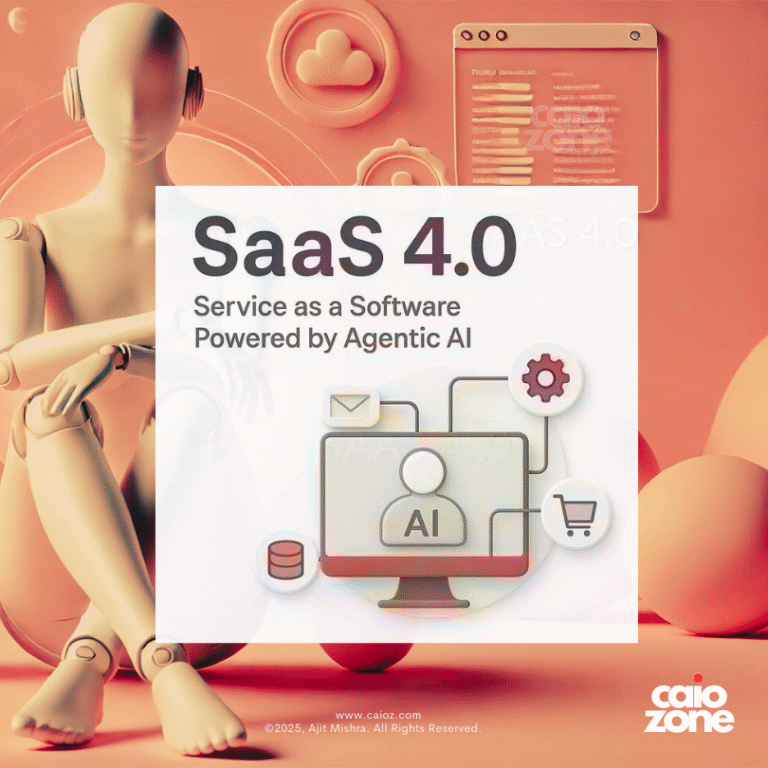🧠 Introduction: The Rise of the Chief AI Officer (CAIO)
As artificial intelligence shifts from pilot projects to enterprise-wide transformation, a new C-suite role is emerging as mission-critical: the Chief AI Officer (CAIO). Once seen as a niche position, the CAIO now plays a pivotal role in shaping strategy, driving ROI, and embedding ethical AI across the organization.
But what makes a great Chief AI Officer?
It’s not just technical expertise. The best CAIOs are visionaries, translators, evangelists, and strategists — all rolled into one. In this article, we break down the 10 key traits that separate good CAIOs from great ones.

Read Ahead:
- 1. 🎯 CAIO Strategic Vision Beyond the Hype
- 2. 💬 CAIO Fluency in Both Tech and Business
- 3. 🧭 CAIO Ethics and Responsible AI Advocacy
- 4. 🏗️ CAIO Mindset for Strong Data & AI Infrastructure
- 5. 🤝 CAIO – A Champion of Cross-Functional Collaboration
- 6. 🧑🎓 CAIO's Lifelong Learning and Adaptability
- 7. 🧩 CAIO – Vendor-Neutral & Open Ecosystem Thinker
- 8. 💡CAIO Evangelism and Internal Change Management
- 9. 💼 Proven Business Execution and Delivery
- 10. 🌐 CAIO Global Perspective and Policy Awareness
- ✅ Conclusion: The CAIO is the CEO of AI in the Enterprise
1. 🎯 CAIO Strategic Vision Beyond the Hype
A great Chief AI Officer doesn’t get caught up in the buzzwords or follow the crowd blindly. Instead, they possess a clear, forward-thinking strategic vision that aligns AI efforts with core business objectives. AI can easily become a science experiment without direction, consuming budgets without delivering results. A great CAIO understands this and focuses on purpose-driven adoption, ensuring AI initiatives aren’t just innovative, but also profitable, scalable, and sustainable. Their strategic mindset transforms AI from a support function to a central pillar of enterprise value creation. This vision helps stakeholders—from executives to engineering teams—stay grounded in business value, not just tech excitement.
Key Focus Areas:
- Identifying high-impact use cases:
A great CAIO evaluates where AI can bring maximum ROI—be it in customer experience, supply chain optimization, or fraud detection. - Building AI roadmaps aligned with OKRs:
Strategic roadmaps ensure AI adoption is structured, phased, and accountable. They tie every initiative to measurable business outcomes. - Avoiding tech-for-tech’s-sake deployments:
Instead of deploying the latest tool just for headlines, great CAIOs evaluate real-world applicability, integration, and impact.
2. 💬 CAIO Fluency in Both Tech and Business
The best CAIOs are bilingual—they speak both “data science” and “boardroom.” This dual fluency allows them to convert deep learning models and inference speeds into language that resonates with executives focused on revenue and risk. Equally, they translate business problems into machine learning terms that data teams can solve. This rare ability makes them the ultimate translator, preventing misalignment, costly delays, and project failures.
Key Focus Areas:
- Translating AI for non-technical stakeholders:
Communicating AI value without jargon builds trust, increases executive buy-in, and accelerates decision-making. - Justifying investments through business KPIs:
Every AI dollar spent should map to a business metric—whether it’s reducing churn, increasing upsells, or improving efficiency. - Aligning AI model outputs with customer value:
Great CAIOs don’t just focus on accuracy—they ensure models enhance user experience, engagement, and retention.
3. 🧭 CAIO Ethics and Responsible AI Advocacy
In today’s world, where facial recognition, autonomous systems, and synthetic content are controversial, the CAIO must lead with integrity. A responsible CAIO ensures that AI is fair, explainable, compliant, and transparent. They define internal guardrails and governance structures so that algorithms don’t accidentally discriminate or break laws. More importantly, they advocate for human-centered AI, ensuring ethical decision-making is embedded in every deployment.
Key Focus Areas:
- Creating ethical AI frameworks:
These are principles and practices for fairness, accountability, and transparency baked into model development from Day 1. - Ensuring explainability and transparency:
Stakeholders must understand why AI made a certain decision—especially in regulated industries like healthcare or finance. - Championing bias detection and inclusive data:
Responsible CAIOs invest in de-biasing models and datasets to reflect diverse audiences and contexts.
4. 🏗️ CAIO Mindset for Strong Data & AI Infrastructure
A powerful model is only as good as the infrastructure supporting it. A great CAIO knows that successful AI initiatives depend heavily on clean, well-governed data, high-performance computing environments, and modern MLOps. They invest time and resources in building robust backbones—data lakes, pipelines, version control, and monitoring systems—that enable AI innovation to scale without friction or risk.
Key Focus Areas:
- Modernizing MLOps pipelines:
Great CAIOs treat model deployment as a repeatable, automated process, just like DevOps. - Improving data quality and lineage:
Garbage in, garbage out. They focus on ensuring that data is clean, labeled, traceable, and continuously updated. - Leveraging scalable, cloud-native platforms:
Cloud-native AI enables flexibility, security, and cost-efficiency, and supports global enterprise needs.
5. 🤝 CAIO – A Champion of Cross-Functional Collaboration
AI affects every corner of an organization, from customer service chatbots to predictive inventory. A CAIO can’t work in isolation—they must collaborate closely with functional heads, understand their pain points, and co-create solutions. The best CAIOs embed themselves into departments as thought partners, helping transform business workflows through AI.
Key Focus Areas:
- Partnering with Marketing and Sales:
From personalization engines to churn prediction, CAIOs help optimize top-line revenue. - Enabling HR with people analytics:
AI can support talent acquisition, engagement tracking, and DEI efforts—if guided by collaborative CAIOs. - Optimizing Operations with AI:
Whether it’s routing, scheduling, or demand forecasting, operations become smarter with AI-aligned leadership.
6. 🧑🎓 CAIO’s Lifelong Learning and Adaptability
AI evolves at breakneck speed. What was state-of-the-art six months ago may be outdated today. A world-class CAIO embraces lifelong learning—constantly exploring new research, tools, regulations, and ethical implications. They adapt strategies proactively, not reactively, and foster a team culture that values curiosity and agility.
Key Focus Areas:
- Staying ahead of AI trends and LLMs:
Great CAIOs attend AI conferences, engage with academia, and actively test cutting-edge models. - Promoting a culture of continuous upskilling:
The CAIO leads by example, encouraging internal AI certifications, learning cohorts, and lab time. - Being open to unlearning and relearning:
As AI’s frontier shifts, the CAIO must discard outdated practices and embrace new paradigms.
7. 🧩 CAIO – Vendor-Neutral & Open Ecosystem Thinker
Rather than getting locked into a single tech stack, elite CAIOs promote flexibility and vendor-neutral strategies. They evaluate open-source and commercial solutions based on use-case fit and integration potential. A modular mindset enables better experimentation, cost control, and innovation.
Key Focus Areas:
- Building hybrid ecosystems (open + proprietary):
Combine the best of both worlds—enterprise-grade stability with open-source agility. - Evaluating tools based on ROI, not hype:
CAIOs compare features, support, scalability, and cost—not just the brand name. - Fostering interoperability and plug-and-play models:
Systems that work well together reduce complexity and speed up AI delivery.
8. 💡CAIO Evangelism and Internal Change Management
AI adoption is not just technical—it’s cultural. Employees often fear automation or distrust AI recommendations. A great CAIO plays the role of internal change agent, leading workshops, AMAs, townhalls, and storytelling sessions that demystify AI. They create momentum and excitement while managing resistance and expectation.
Key Focus Areas:
- Hosting internal AI bootcamps:
These help demystify models, explain real-world use cases, and build excitement. - Creating AI “champions” in every department:
These ambassadors help drive bottom-up adoption and feedback. - Humanizing AI through storytelling:
People relate to stories, not stats. A CAIO who inspires through storytelling wins hearts and minds.
9. 💼 Proven Business Execution and Delivery
The CAIO’s ultimate job is not evangelism—it’s delivery. All AI efforts must result in real business outcomes. A high-impact CAIO knows how to manage AI projects, drive execution, measure success, and continuously improve. They balance innovation with accountability, ensuring every project ladders up to strategic goals.
Key Focus Areas:
- Managing AI initiatives like business programs:
They set timelines, budgets, and delivery milestones, just like any transformation initiative. - Measuring AI ROI clearly:
Whether through revenue impact or cost savings, great CAIOs make results measurable. - Scaling successful use cases across functions:
Once one team sees success, the CAIO replicates the model across the organization.
10. 🌐 CAIO Global Perspective and Policy Awareness
As governments begin regulating AI, global awareness is a must. Great CAIOs stay on top of policy shifts across continents, ensuring their organization is not only compliant but also proactive in shaping industry norms. They participate in AI consortiums, contribute to policy dialogue, and balance compliance with innovation.
Key Focus Areas:
- Tracking global AI regulations (EU AI Act, India AI, US Executive Orders):
Staying updated prevents future compliance surprises and builds trust. - Ensuring cross-border data and model governance:
Great CAIOs consider where data is stored, where models are trained, and how they’re used globally. - Engaging in public-private dialogues:
They bring the enterprise view to the table in shaping national AI strategies.
✅ Conclusion: The CAIO is the CEO of AI in the Enterprise
The Chief AI Officer is no longer a “nice to have” — they are the CEO of AI within the enterprise. The best CAIOs combine business acumen, tech fluency, ethical grounding, and storytelling to drive impact across people, platforms, and processes.
If your company is serious about leveraging AI not just for automation, but for competitive advantage, invest in a CAIO who embodies these ten traits—and watch the transformation unfold.













